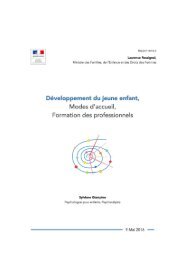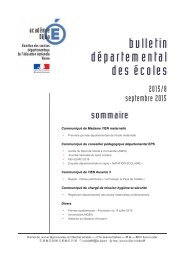agrl_innovations_in_ssa.pdf?utm_content=buffercb41d&utm_medium=social&utm_source=twitter
agrl_innovations_in_ssa.pdf?utm_content=buffercb41d&utm_medium=social&utm_source=twitter
agrl_innovations_in_ssa.pdf?utm_content=buffercb41d&utm_medium=social&utm_source=twitter
Create successful ePaper yourself
Turn your PDF publications into a flip-book with our unique Google optimized e-Paper software.
Box 4: NASFAM structure<br />
The National Smallholder Farmers Association of Malawi (NASFAM) orig<strong>in</strong>ated as a USAID-funded<br />
project to support and organise tobacco production. S<strong>in</strong>ce 1995, NASFAM has promoted diversification<br />
away from dependency on maize and tobacco, support<strong>in</strong>g production of alternative crops <strong>in</strong>clud<strong>in</strong>g:<br />
chillies, groundnuts, rice, soybeans, sunflowers and other crops as and when opportunities occur.<br />
NASFAM functions are split between commercial and development activities. Commercial activities<br />
<strong>in</strong>clude the market<strong>in</strong>g of <strong>in</strong>puts to, and produce from farmers. Development activities, which are often<br />
donor-funded, <strong>in</strong>clude community development and capacity-build<strong>in</strong>g services for staff and NASFAM<br />
members.<br />
The smallest operational NASFAM unit is the Club compris<strong>in</strong>g 10–15 <strong>in</strong>dividual smallholder farmers.<br />
Clubs comb<strong>in</strong>e to form Action Groups, which are the focus po<strong>in</strong>t for extension and dissem<strong>in</strong>ation of<br />
<strong>in</strong>formation and bulk<strong>in</strong>g of produce for market<strong>in</strong>g. Action Groups <strong>in</strong> turn comb<strong>in</strong>e to form Associations<br />
of which there are currently 40 across Malawi. These are legally registered entities, memberowned<br />
and managed by Farmer Boards. Associations are grouped by geographical location under<br />
14 different Association Management Centres (AMCs), which provide management and operational<br />
support to the Associations for production, market<strong>in</strong>g and community development. Each AMC is<br />
supported by NASFAM Regional and Head Offices. This <strong>in</strong>cludes support and guidance to members<br />
on the organisation and management of small-scale bus<strong>in</strong>esses, access to <strong>in</strong>puts, advice, technical<br />
support and tra<strong>in</strong><strong>in</strong>g on crop management and agronomic practices, harvest<strong>in</strong>g and postharvest crop<br />
management. In addition NASFAM provides market<strong>in</strong>g support, facilitat<strong>in</strong>g the bulk<strong>in</strong>g of member’s<br />
crops to secure access to the most profitable markets for reliable <strong>in</strong>come.<br />
Much of this is undertaken through NASFAM’s farmer-to-farmer tra<strong>in</strong><strong>in</strong>g programmes, where<br />
progressive members are tra<strong>in</strong>ed to tra<strong>in</strong> fellow members on successful and best bet practices<br />
<strong>in</strong>clud<strong>in</strong>g:<br />
• Seed selection, use of fertiliser and chemicals<br />
• Land preparation, plant<strong>in</strong>g and crop husbandry, promot<strong>in</strong>g environmentally and susta<strong>in</strong>able natural<br />
resource management (NRM) practices<br />
• Provision of crop production estimates for market<strong>in</strong>g plans<br />
• Harvest and postharvest techniques for dry<strong>in</strong>g and grad<strong>in</strong>g<br />
Through its network of Associations, NASFAM facilitates the procurement, bulk<strong>in</strong>g and transport<br />
of members’ produce to the po<strong>in</strong>t of sale. It works to identify and secure domestic, regional and<br />
<strong>in</strong>ternational markets for its members’ produce.<br />
Source: NASFAM, 2011<br />
content. After <strong>in</strong>troduction of the farmer tra<strong>in</strong><strong>in</strong>g programmes, results showed 39 percent of<br />
the groundnuts were aflatox<strong>in</strong> free, 29 percent had levels <strong>in</strong> the range 1–2 ppb, 20 percent<br />
2–4 ppb and 12 percent over 4 ppb, show<strong>in</strong>g that farmers had started to improve their crop<br />
management and postharvest<strong>in</strong>g management practices thus reduc<strong>in</strong>g aflatox<strong>in</strong> levels. It<br />
was also evident that progress varied between areas. This process of test<strong>in</strong>g cont<strong>in</strong>ued for a<br />
number of seasons and showed cont<strong>in</strong>u<strong>in</strong>g improvement <strong>in</strong> reduction of aflatox<strong>in</strong> levels with<br />
a high proportion meet<strong>in</strong>g export standards. Although aflatox<strong>in</strong> levels have shown a gradual<br />
decl<strong>in</strong>e, weather conditions dur<strong>in</strong>g maturity and harvest can have significant <strong>in</strong>fluence on yearto-year<br />
variation. This requires ongo<strong>in</strong>g monitor<strong>in</strong>g so that production standards cont<strong>in</strong>ue to<br />
meet export requirement standards, especially <strong>in</strong> the face of competition from traders and<br />
vendors who do not require the same standards to be met.<br />
The case studies: Southern Africa 51






